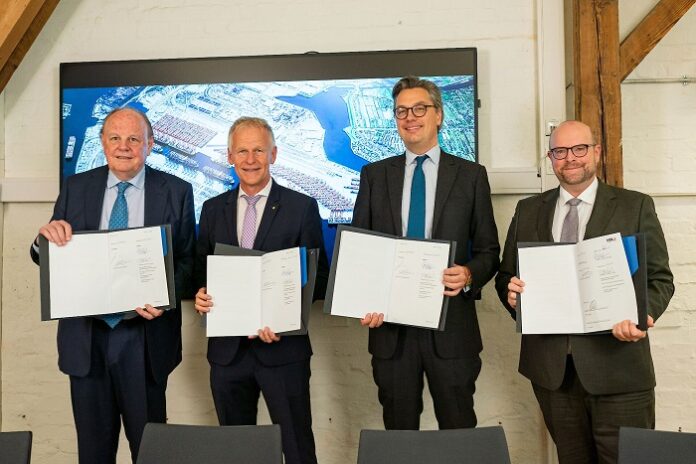Hamburg invests 1.1 billion in port infrastructure expansion

The Elbe approach to the Waltershofer Hafen is to be enhanced and additional terminal yards are created. Navigation towards the Container Terminals Buchardkai (CTB) and Container Terminal Hamburg (CTH) will be easier and faster. New land for terminal operations will create additional capacity and enable further modernisation of container throughput operations.
Around 90 per cent of the largest container vessels calling at Hamburg are currently handled at the Waltershofer Hafen. The turning basin will be widened from its current 480 metres to 600 metres. Vessels will have a larger water surface available for turning manoeuvres, ensuring optimal performance and safety.
This will enhance navigational safety and operational efficiency for current and future vessel sizes at Hamburg’s busiest container throughput area, while improving navigability and resilience along the River Elbe. All berths in the Waltershofer Hafen will benefit from this measure, which is expected to increase throughput efficiency.
The creation of additional berths will also improve terminal workflows: going forward, processes can be automated and electrified – a key contribution to decarbonisation.
In addition to the public investment, Eurogate has signed a preliminary lease agreement for the new areas and will invest at least EUR 700 million in expanding the existing container terminal, with completion planned within two years of the handover of the newly developed land.
Hamburg’s Minster for Economic Affairs, Senator Dr Melanie Leonhard: “Today, we are laying the groundwork to ensure that Hamburg is well prepared to meet the challenges of tomorrow. Projects of this magnitude require meticulous planning and long-term implementation. This infrastructure will help ensure that large vessels will be handled reliably and efficiently in the Port of Hamburg. It also strengthens Hamburg’s service capacity and reinforces its role as a key hub on major international shipping routes.“
To strengthen the Port of Hamburg in its vital role as a supply hub for Germany, the existing port infrastructure must be continuously adapted and optimised. The planned measures are anchored in the Senate’s Port Development Plan and the Hamburg Government’s coalition agreement.
The future terminal areas will remain in public ownership and be leased to EUROGATE by the HPA under market-based conditions. These areas will extend the existing Container Terminal Hamburg (CTH) and will be fully integrated into the road and rail network. As a contiguous operating space, the site will allow for efficient and sustainable management. This will enable the implementation of modernisation measures and an operating concept in which containers are moved using electrically powered, autonomously guided vehicles. This marks a significant step towards achieving climate neutrality by 2040. Once the HPA, on behalf of the City of Hamburg, has completed the land development, EUROGATE will be responsible for implementing the operational and innovation concept.
To create the new port operating area, soil will be excavated from the eastern headland north of the Petroleumhafen and along the Bubendey bank. The existing port basin will then be infilled after being sealed off from the river by a dam.
The authorities have already approved the plans, and following the dismissal of all legal challenges, construction of the public infrastructure can proceed.
As public funding is planned for the construction of the public infrastructure, approval from the European Commission is required. This state aid assessment process may take several years. To ensure maximum legal certainty for the chosen procurement approach, the HPA is voluntarily conducting an upstream ex-ante review process, with results expected in 2026.




